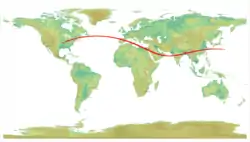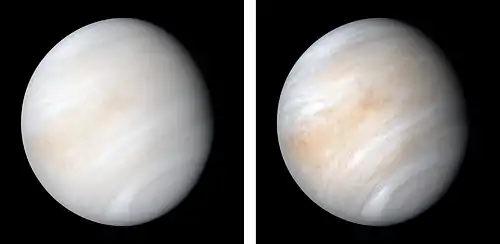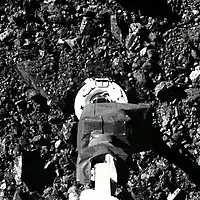2020 VV
2020 VV is an Apollo near-Earth asteroid roughly 12 meters (40 feet) in diameter. According to the Sentry monitoring system, the asteroid has a 1 in 1.5 million chance of impacting Earth on 12 October 2033 11:43 UT.[4] The asteroid has a modest 61 day observation arc. The nominal Earth approach is on 18 October 2033 at a distance of 0.01 AU (1,500,000 km; 930,000 mi), but the line of variations (LOV) is only known with an accuracy of ±2 days.[3] The line of variations allows the asteroid to impact Earth[lower-alpha 1] or pass as far away as 0.02 AU (3,000,000 km; 1,900,000 mi).[3] With a diameter range of 10–22 meters the asteroid could be as large as the Chelyabinsk meteor.
 The risk corridor for the 2033 virtual impactor passes over the northeastern USA, Spain, Saudi Arabia, India, and China.[1] | |
| Discovery[2] | |
|---|---|
| Discovered by | Mount Lemmon Survey (G96) |
| Discovery date | 5 November 2020 |
| Designations | |
| 2020 VV | |
| Orbital characteristics[3] | |
| Epoch 2020-May-31 (JD 2459000.5) | |
| Uncertainty parameter 5 | |
| Observation arc | 61 days[4] |
| Earliest precovery date | 17 October 2020 |
| Aphelion | 1.2367 AU (185,010,000 km) (Q) |
| Perihelion | 0.9830 AU (147,050,000 km) (q) |
| 1.1099 AU (166,040,000 km) (a) | |
| Eccentricity | 0.1143 (e) |
| 1.17 yr | |
| 268.100° (M) | |
| Inclination | 0.350° (i) |
| 20.148° (Ω) | |
| 330.663° (ω) | |
| Earth MOID | 14,800 km |
| Jupiter MOID | 3.96 AU (592,000,000 km) |
| Physical characteristics | |
Mean diameter | ~12 meters (40 feet)[4] 10–22 meters (CNEOS) |
| 27.25[3] | |
2020 VV was discovered on 5 November 2020 when it was about 0.036 AU (5,400,000 km; 3,300,000 mi) from Earth and had a solar elongation of 150 degrees. It has a very low 0.35° orbital inclination with respect to the ecliptic plane and an Earth-MOID of only 14,800 km.[3] The asteroid passed Earth on 21 October 2020 at a distance of 0.0215 AU (3,220,000 km; 2,000,000 mi).[3]
Where Earth will be on a given date is known, but given the short observation arc where precisely the asteroid will be on its orbit in 2033 is not. A slight variation in the known orbit of the asteroid can cause the asteroid to be early, right on time (impact solution), or late.[lower-alpha 2]
Impact probabilities are calculated independently by Sentry, NEODyS-2 and ESA's Space Situational Awareness Programme. Different models result in slightly different orbit solutions, nominal close approach distances, and impact probabilities.[5] With a long enough observation arc these solutions will converge. In general when the nominal approach is closer to the impact scenario, the odds of impact are greater.
| Date and time | Nominal closest approach | Position uncertainty[lower-alpha 3] | Impact probability on 12 Oct 2033[lower-alpha 4] |
Reference |
|---|---|---|---|---|
| 12 October 2033 11:43 | Impact scenario | ±2.5 hours | Sentry[4][lower-alpha 2] | |
| 17 October 2033 17:35 | 0.0099 AU (1,480,000 km) | 0.000930 AU (139,100 km) | none | NEODyS-2[6] |
| 17 October 2033 17:35 | 0.0099 AU (1,480,000 km) | 0.000989 AU (148,000 km) | none | ESA[7][8] |
| 18 October 2033 00:38 | 0.0107 AU (1,600,000 km) | 0.002407 AU (360,100 km) | 0.00007% | JPL SBDB[3][4] |
The line of variation (risk corridor) passes over the northeastern USA, Spain, Saudi Arabia, India, and China.[1]
2020 VV is not categorized as a potentially hazardous object, because the estimated size is significantly smaller than the threshold of about 140 meters for potentially hazardous objects.
The greatest chances of impact were listed between 17 and 20 November 2020. On 17 November 2020 the Space Situational Awareness Programme listed a 4.2% chance (1 in 24) of impact,[9] Sentry listed a 2.8% chance (1 in 36),[10] and NEODyS-2 listed a cumulative 5.9% chance of impact.[10] By 20 November 2020 with a 15-day observation arc NEODyS-2 listed a 4.4% chance (1 in 23) of impact.[11][lower-alpha 5] At the same time, Sentry listed a 1.3% chance (1 in 77) of impact, and the Space Situational Awareness Programme listed a 1.6% chance (1 in 63).
Notes
- Though still listed on the more thorough Sentry Risk Table, the JPL Small-Body Database shows a minimum possible distance of 0.003 AU (450,000 km) from the center of Earth, which is way outside the 6,371 km radius of Earth.
- Earth traveling at 30 km/s and with a diameter of 12,800 km, only blocks the path of single virtual impactor for about 8 minutes (30*60*8). Due to an Earth-like orbit, the virtual asteroids can impact Earth for about ±2.5 hours centered around the virtual impactor at 12 October 2033 11:43 UT. If 2020 VV is not crossing Earth's orbit during that time there can be no impact.
- The JPL SBDB close-approach data min/max distance and time of close approach uncertainty correspond to the 3-sigma level. Stretching "Semi-major axis (km)" corresponds to the 1-sigma uncertainty. 3-sigma uncertainty is 3 times larger.
- Impact probability examples: 1.00 would be 100%. 2.00E-2 would be 2%.
- At the same time, NEODyS-2 listed an additional 0.15% chance (1 in 650) of impact at a later date, 10 October 2038.
References
- Steven M. Tilley (16 November 2020). "Finding a Risk Corridor For the Asteroid 2020 VV". The Asteroid News. Retrieved 16 November 2020.
- "MPEC 2020-V35 : 2020 VV". IAU Minor Planet Center. 6 November 2020. Retrieved 14 November 2020. (K20V00V)
- "JPL Small-Body Database Browser: (2020 VV)" (last observation: 2020-11-23; arc: 61 days). Jet Propulsion Laboratory. Archived from the original on 13 November 2020. Retrieved 18 December 2020.
- "Earth Impact Risk Summary: 2020 VV". NASA/JPL Near-Earth Object Program Office. Archived from the original on 17 November 2020. Retrieved 18 December 2020.
- "Impact Monitoring information now computed by NEOCC". Retrieved 28 November 2020.
- "2020VV close approaches". NEODyS-2. Archived from the original on 16 November 2020. Retrieved 18 December 2020.
- "esa space situational awareness: 2020 VV". esa Space Situational Awareness Programme. Archived from the original on 16 November 2020. Retrieved 18 December 2020.
- "Possible impacts: 2020 VV". esa Space Situational Awareness Programme. Archived from the original on 20 November 2020. Retrieved 18 December 2020.
- "Archive: 17 Nov 2020 esa Space Situational Awareness Risk List (2020 VV)". esa NEO Coordination Centre. 17 November 2020. Retrieved 17 November 2020.
- "hohmanntransfer 17 Nov 2020 archive of 2020 VV on NEODyS and Sentry". hohmanntransfer. 17 November 2020. Retrieved 17 November 2020.
- "Archive: 20 Nov 2020 NEODyS impact probability for 2020 VV". NEODyS-2. 20 November 2020. Archived from the original on 20 November 2020. Retrieved 20 November 2020.
External links
- 2020 VV at NeoDyS-2, Near Earth Objects—Dynamic Site
- Ephemeris · Obs prediction · Orbital info · MOID · Proper elements · Obs info · Close · Physical info · NEOCC
- 2020 VV at ESA–space situational awareness
- Table of Asteroids Next Closest Approaches to the Earth Osservatorio Astronomico Sormano
- Sentry (6 Nov 2020) with impact years ranging from 2027-2118 / 2020 VV entries – hohmanntransfer
- Asteroid Hazards, Part 3: Finding the Path – YouTube video by the Minor Planet Center (26 August 2015)


_on_Jul_14_2020_aligned_to_stars.jpg.webp)
